

| Little Things Japanese |
| To Little Things Japanese 2 |
| A friend of mine once told
me that"On the surface Japan is like a Western country---the way people
dress, how buildings look etc.--- but it doesn't take much to scratch off
the surface and see what's laying under the masks." I found this observation
very interesting. One of the major attractions of traveling abroad, of course, is to see things that are different from what you are used to seeing in your own country. It's exciting to be surrounded by an environment where everything (language, landscape, buildings, foods, etc.) is different. However, as my friend said, it does't take those big things (language, landscape, how people dress)to really experience a foreign country. In fact, it is often those LITTLE, interesting and sometimes baffling (even weird) discoveries, such as people's mannerisms and behavior, fashion trends, resourceful goodies, informal customs, etc. that give you the opportunity to REALLY see the country you are visiting. Here in this page, I would like to introduce some examples of those LITTLE things. |
| Comments from visitors I think what is fascinating is the manhole covers. There are very beautiful with pictures on them. The ones we have in the states are boring compared to Japans. I think people should make a point to look down every now and then to see the manhole covers. Judy |
| As an American
friend and I were sitting on a train station's platform bench she suddenly
started chuckling and said, "This just doesn't happen in the States."
I had no clue what she was referring to, but she soon told me how interesting
it was to her eyes to see all those people standing in two neat lines (often
four, two being for the next train and the other two for the train after
the next) waiting for a train and for the passengers to get off first,
on arrival, instead of shoving their way on to the train and soon more
lines being formed. She even mentioned the scene resembling a military
drill! (I disagreed!) |
| One
of the things that you probably notice first when you get on a train in
Japan is the number of people asleep. I have gotten so used to seeing it
that it has become normal. Of course, I am sure it is not only in Japan
that people fall asleep on a train, but I think it is the number of people
asleep that seems to surprise foreign visitors. I am sorry. There is no picture available. |
| Japan is a vending machine heaven!
No doubt about it. Everywhere you go you see vending machines. Even though
most of them sell either cigarettes or drinks (including alcoholic beverages),
there are ones that sell more unusual things such as eggs, rice, magazines,
ice cream, instant noodles(hot water supply system), sweets, snacks, batteries.
Vending machines have come under criticism that they are wasting energy
and no argument can be made for that, but why do we have so many vending
machines, I wonder? Do you have any theory on this? Cigarette and alcohol
vending machines are so abundant that it is very easy for minors to get
ahold of these things. Besides, I don't think shop clerks ask for young
people's IDs unless they are wearing school uniforms. Only a few years
ago did the government ban vending machine owners from selling those things
on vending machines from 11 p.m. to 5 a.m. I don't think it helps much. |
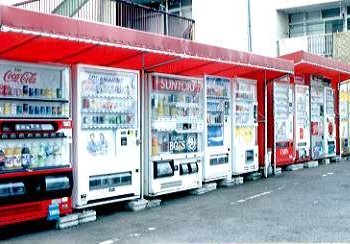 |
It's not unusual to see vending machines lined up like this. They are all for cigarettes or soft drinks. |
 |
A vending machine that sells flowers! I had never seen vending machines that sell flowers until the very day when I took this picture! |
| A vending machine for magazines.
Often adult-oriented magazines are sold in magazine vending machines. BUT not this one. |
 |
It's hard to make out what is in this
picture, but this is a vending machine selling disposable cameras. | |
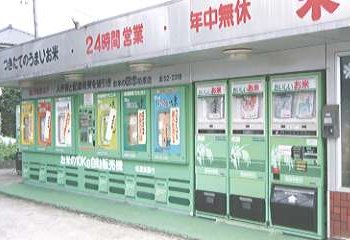 |
Well, it is not surprising for
us to have rice vending machines considering the amount of rice we consume every year, is it? |
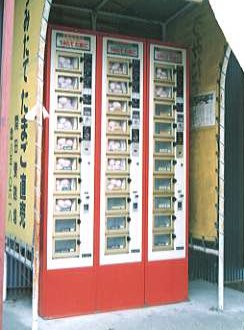 |
Egg vending machine.. usually they are set up just outside of egg farms. |
Vending machines for Omikuji!!! Even though I know Omikuji are just for fun and shouldn't be taken seriously, it always makes me happy to get a good one. But getting omikuji from a vending machine somehow takes all the fun away. |
|
| Comments from visitors I work at a telcomunications center in San Antonio, Texas. Within our breakroom there are several vendig machines. There are the usual - cold soda/water/gatorade & bagged snacks; however, we do have a hot drink vending machine. You select the drink you want, i.e. coco, coffie, or hot tea, and a little cup ( you pick a size ) drops down into a little slot where the fluid of your choice flows into from above. Thene we have another vending machine which vens many things we find of neccesity in the USA, such as nail clippers, mints, combs, headach medicine, bandades, chapstick, tissue, and pens. Jennifer |
| When walking down a busy street
, you sometimes might see people (especially in front of big train stations)
handing out pocket tissues for advertising reasons. If you become low on
tissues I recommend you find these people and walk by them a few times. |

|
| I don't know how election campaigning is done in other countries, but in Japan, candidates go around in a car asking for voters support through loud speakers, occasionally making stops to talk about their campaign policies. Pictures below were taken during the election campaign for an Upper House election held in July. |
Comments from visitors
| What really surprised me was that there are no non-smoking places.
I know the Japanese are always really concerned about health, but they
smoke anywhere and everywhere, especially the younger men. None of the
books I read or anything prepared me for this. Julie |
| Comic books are very popular
in Japan, not just among young people but also among adults as well. However,
seeing serious- looking Japanese business men in suits reading comics on
a train seems surprising to many foreign visitors here. And what is more
surprising is that you sometimes see men reading magazines and tabloids
that have graphic, and a lot of times, revealing pictures, in public places!
This is outrageous,isn't it? |
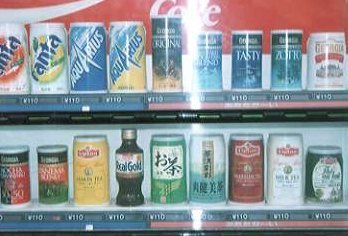 These are close up shots of a vending machine. Displays with the red strips below them are hot drinks, while blue are cold drinks.. |
One of the things that seems to surprise many people from abroad is hot canned drinks. As mentioned above, there are zillions of vending machines for drinks in Japan, and most of them do sell not just cold drinks, but also hot drinks as well (especially in winter), such as coffee, tea and corn chowder etc. I don't remember exactly whether they were surprised because hot canned drinks can be bought from vending machines, or because of the very existence of hot canned drinks. Do you have hot canned drinks or vending machines that sell hot canned drinks in your country? Let me know in the "Message Board" section. |
| You sometimes see women in their
40's, 50's, and even 60's with dyed hair in Japan. "So?" You
might ask. Well, it is not black that they dye their hair. Of course, there
are lots of people, just like in any other country, who dye their hair
to cover up the gray hair, but there are also some people in Japan who
dye their hair color blue, purple or red. Dying your hair when you are
young generally gives a "rebellious" kind of image, but to do
it at the age of 50 or 60… hmmm.. Speaking of hair, a friend of mine from
Australia once told me that some of her middle-aged female students at
her English language school sometimes wear their hair in pigtails, which
is unusual, she said, in her country. I had never really given much thought
to these things until some friends from other countries pointed them out
to me. I think these are just examples of cultural differences. I am sorry. There is no picture available. |
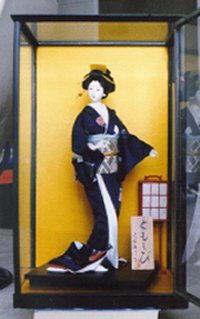 |
One item which I feel is definitely deserving of being mentioned is the 'ningyou.' The very first time I visited Japan, on my very first day there, I stayed at my friends' home in Yokohama. The very first thing I saw when I entered their home was a gorgeous doll ('ningyou') in her glass display case. I was unaware of this [relatively recent?] tradition. Over the years, during repeated visits, I became quite taken by these 'household dolls' which I saw in some other homes, as well as in depaatous, and specialized shops. Many are a bit 'gaudy' and 'busy' in terms of colour and accessories. These, I've been told by a law student at Keio, are more for the tourist trade. Others, however, have a quiet elegance and beauty which exhudes much of the Japanese philosophy on esthetics. My Yokohama friends' ningyou was definitely of the latter category. They'd had her for a couple of decades and she was a centerpiece of their home. Which added to my shock when they told me, during my most recent trip, that they had decided they wanted me to have her Everyone who has seen her (either the photo on my desk at work, or in person at my home) have been very impressed at the crafstmanship and loveliness of this Japanese artifact. |
Comments from
visitors
| On my visit to Japan i couldnt help but notice how clean the streets
were even for a major city like Tokyo. I did not see one single piece of gum on the side walk at all. Coming from Ny this is a bit unusual. I also saw that almost the whole population had cellular phones all with some sort of trinket or ornament on it aswell. Unknown |
| To Little Things Japanese 2 |
| HOME |